Please refer to the document
SBC6410 Burning Guide(Android2.3.4).pdf
SBC6410 Burning Guide(Linux).pdf
SBC6410 Burning Guide(Wince6.0).pdf
Products
- -Single board computer
- +Rockchip
- SBC3588 Idea3588 Idea3588S Idea3576 SBC3576 EM3576 SBC3568 EM3568 EM3568-AV CAM SBC3566 EM3566 EM3562 EM3326S Idea1126B-P EM1126 SBC3399 Idea3399 EM3399 Idea3288 EM3288 EM1808 EM3128 EM1103B SBC1108
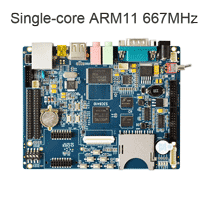
* Processor: Samsung S3C6410. ARM1176JZF-S, 667MHz
* RAM: 128MB/256MB
* Storage: 256MB/512MB/1GB
* Interface: 1x USB Host, 1x USB OTG, 4x UART, LCD, Ethernet, JTAG, Audio, RTC, SD, GPIO, Camera, WIFI, TVOUT
* Operating system: Linux 2.6.28, WinCE6.0, Android 2.3
* Dimensions: 121 x 100 mm
* Expansion Module: 3G model, GPS, GPRS, WiFi, Bluetooth, Camera, LCD
SBC6410 is a single board computer based on Samsung S3C6410 - an advanced ARM11 CPU for running operating system and application code, and for dedicated video processing. Low voltage Mobile DDR enables very low power consumption in regular operation and in standby. For embedded applications, the SBC6410 provides a general purpose local bus, 100Mbit Ethernet, serial ports, I/O lines and other essential functions, while integrated WiFi interface implement industry standard wireless connectivity. The small size and low power consumption of the SBC6410 allows its integration into hand-held and mobile devices, while its low price makes it an ideal selection for cost-sensitive applications. It is able to support Android, Linux and WinCE6.0 embedded OS. The SBC6410 embedded SBC delivers a price / performance ratio significantly better than that of any other platform.
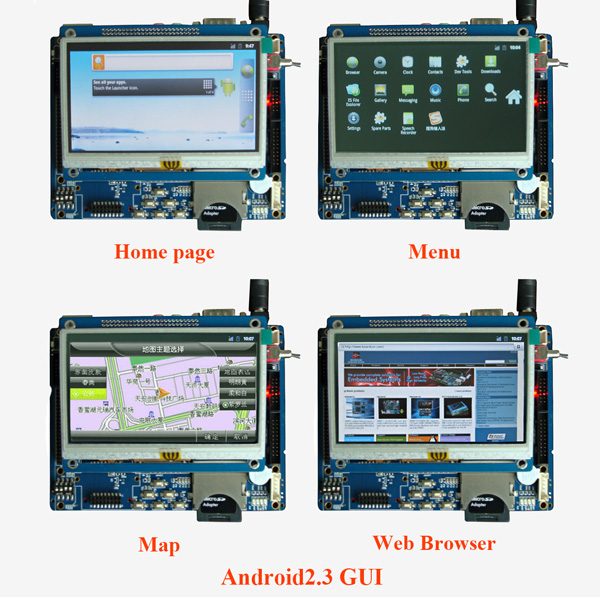
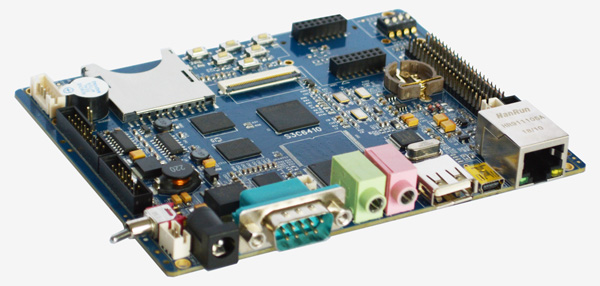
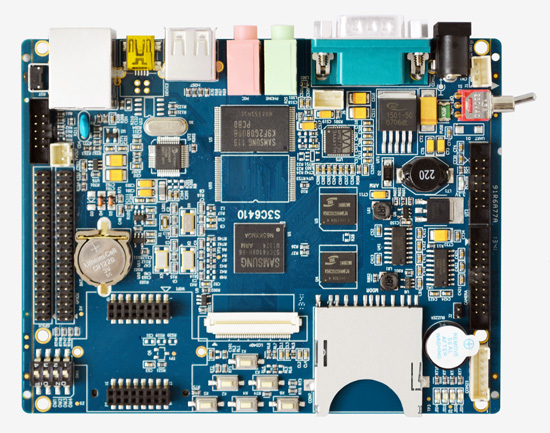
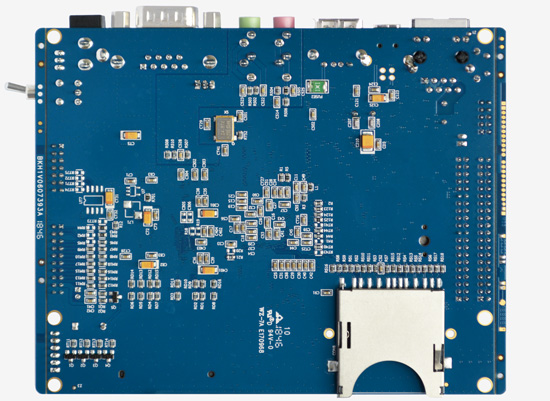
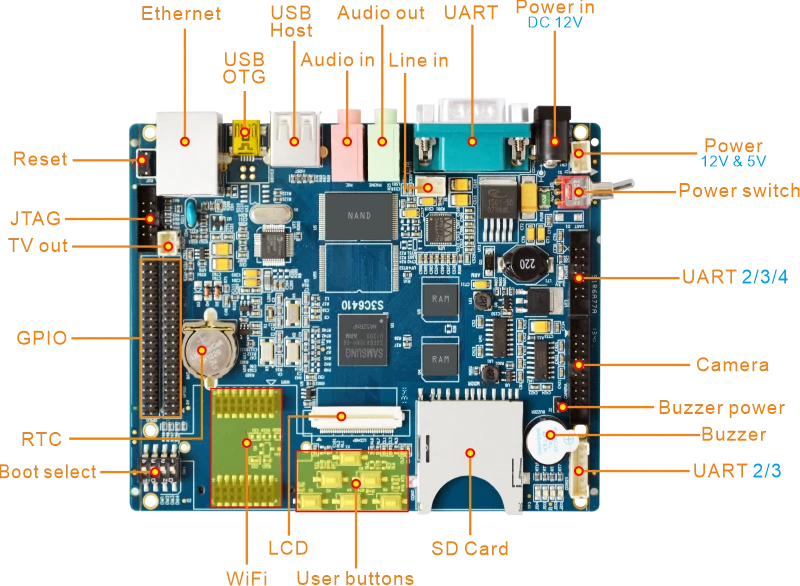
| Specifications | |
|---|---|
| SoC | Samsung S3C6410, ARM1176JZF-S, up to 667MHz |
| Memory | 128MB Mobile DDR SDRAM, 266MHz |
| Storage | 256MB SLC NAND Flash. 512MB-1GB SLC/MLC Flash optional 2x SD card slot |
| EEPROM | Support I2C, it can be soldered with AT88SC016 for encryption |
| Serial Ports | 4x UARTs |
| LCD | 4.3-/ 7- inch TFT LCD with resistor touch screen |
| Connectivity | 10/100 Mbps Ethernet RJ45 port via DM9000AEP controller Optional SDIO WIFI Module, supporting IEEE802.11b/g Optional USB WCDMA Module, dual mode Optional GPRS module, SIMENS MC388, GSM network Opional GPS Module, GR-87 Serials |
| USB | 1x USB1.1 Host, 1x USB2.0 OTG |
| JTAG | 1x 10-pin JTAG Port |
| Audio | WM9713 Audio chip. 2x 3.5mm audio jack for Audio input/output 1x 3-pin connector for line in |
| RTC | Real Time Clock, powered by external lithium battery |
| GPIO | GPIO, ADC, SPI, IIC, I/O, Interrupts and MMC are in 2x 40-pin header |
| Buttons | 6x User Buttons |
| Camera(optional) | CMOS Camera, 20-pin header connector |
| Dimensions | 121 x 100 mm |

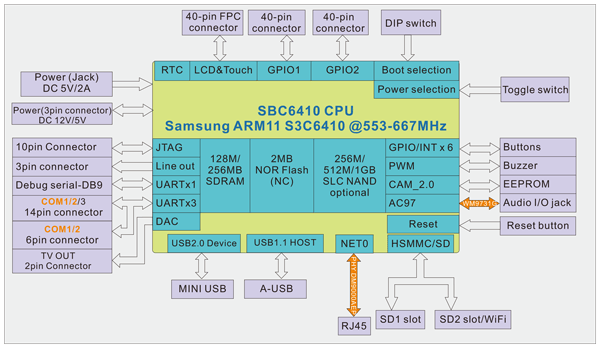

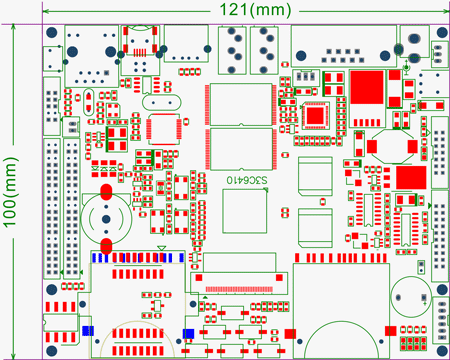
 Product Configuration
Product Configuration
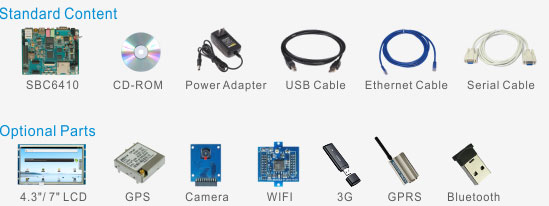
| OS | Item | Feature | Description |
|---|---|---|---|
| Linux2.6.28 | Bootloader | u-boot | u-boot-1.1.6 Main functions: 1. Suppor Nand Flash erase/write/read 2. Support USB download Image 3. Support print, set, save Environment Variables 4. Support memory's contents display/compare/modify 5. Support bootm, bootargs setting |
| Sdboot | 1. SD Card boot-up and download Image via USB (can replace JTAG) 2. Replace booting LOGO |
||
| Image update | SupportImage update from SD Card or USB | ||
| Kernel and drivers | Version | Linux 2.6.28.8 | |
| File system Format | ROM/CRAM/EXT2/EXT3/FAT/NFS/JFFS2/UBIFS | ||
| Drivers | DDR RAM, Nand Flash, Serial ports, RTC, Ethernet, 4.3" and 7"LCD including Touch Screen, MMD/SD, USB Host, LEDs, AC97, Camera, USB Keyboard and Mouse, IIC, SPI, WAVEDEV, DMA, JPEG, MFC, TVOUT, OpenGLES1.1&2.0, D3DM | ||
| File System | File System | Yaffs or NFS File System | |
| Function | Provided Lib (ALSA -lib, tslib, glibc), udev support | ||
| Embedded GUI | Qtopia 2.2.0 | Support file browser, Mediaplayer, Calendar, time, counter, Touch Screen Calibration program, Plug-in manager. | |
| Network protocol & application |
Network protocol | TCP/IP protocol, Telnet, FTP Client/server, Boa webserver | |
| Application | H.264 display, MPEG-4 display, H.263 display, VC-1 display, 4-windows display, Camera preview & MFC encoding, MFC decoding & Camera preview, Camera input and JPEG encoding, JPEG decoding and display, MFC decoding & Camera preview thru TV, H.264 decoding thru TVOUT | ||
| Cross compiler Environment | 3.3.2 , 3.4.1 , 4.3.3-eabi | ||
| OS | Item | Feature | Description |
|---|---|---|---|
| WinCE6.0 | Boot | Stepldr | Providing Source code and STEPLDR.bin |
| Eboot | Providing Source code and EBOOT.bin Eboot main functions: 1. Ethernet download: Set static IP, HDCP gets Dynamic IP, Mac address setting, download kernel automatically by Ethernet when the system starts. 2. USB download: update the image via USB OTG 2.0 3. Format Nand Flash 4. Format BinFS 5. Low-level Format 6. Set boot-up delayed time 7. Booting process bar |
||
| Sdboot | 1. SD Card boot-up and download Image via USB (can replace JTAG) 2. Replace booting LOGO |
||
| System | Driver | 1. 4.3" and 7" LCD including Touch Screen, TVOUT, LEDs 2. Supporting 16/18/24Bpp 3. Supporting LCD display rotate |
|
| SD card, High speed SD card, SPI, AC97, Camera, Ethernet, USB Host, USB Device, Serial ports, RTC, GPS, WIFI, IIC, JPEG, SPI, Keyboard, NandFlash, wavedev, CF_ATA, CMM, DMA, DrvLib, MFC, Powerbutton, Powercontrol, UA0 | |||
| Function | 220MB NAND Flash for user | ||
| Power Management (backlight drive, battery-driven, sleep/wake-up function), Hive registry support, ROM file system support | |||
| Application | MFC Video Encode/decode |
Providing Source Code and user manual, supporting MPEG-4/H264/H263/VC-1 and API operation manual | |
| DirectShow Filter | Providing Source Code including: AACDecoderFilter, FrameExtractFilter, MFCDecoderFilter, MP4testcode, mpeg4ip_mp4v2, SsapMP4Parser |
||
| JPEG | JPEG/JPG encoding and decoding, providing driver and test program. | ||
| OpenGL | OpenGL ES1.1&2.0, providing source code and user manual | ||
| Camera | Supporting CMOS Image sensor-ov9650/9653/9655 | ||
| TCPMP | Hardware decode MPEG-4/H263/H264/VC-1, supporting avi, mp4, m4v, mov, 3gp, flv, MPG. Supporting DIVX, XVID Supporting MP1, MP2, MP3, AC3, AAC more audio kinds. |
||
| OFFICE | Word, Excel, PowerPoint, PDF, txt, Skype |
| OS | Item | Feature | Description |
|---|---|---|---|
| Android2.3 | Boot | Version | U-boot 1.1.6 |
| Boot Mode | Boot Android from SD card, NAND Flash | ||
| Image update | Support updating image from SD card or USB | ||
| Kernel and drivers | Version | Linux 2.6.36-Android | |
| Drivers | DDR, Flash, Serial ports, RTC, 4.3" and 7" LCD including Touch Screen, MMD/SD, High Speed SD card, user buttons, DM9000, IIC,SPI, keyboard, WAVEDEV, DMA, USB device, JPEG, MFC, TV OUT, Rotator, OpenGGES1.1 & 2.0, D3DM | ||
| Application | Alarm Clock, ASTRO, Mediaplayer, Music, Picsay, Gallery, Browser, Panda Reader | ||
| File System | File System Format | Yaffs2 (Androidfs-sdk-m5-rc15) | |
| Embedded GUI | Android2.0 | Support file browser, Mediaplayer | |
| Cross compiler Environment | Arm-none-linux-gnueabi | ||
| Debug Tools | DNW,MoviNAND_Fusing_Tool.exe | ||
| Datasheet |
|
|
|
|
|
|
| Reference Manual |
|
|
|
|
|
|
|
|
|
|
| Expansion Module | Module Detail | Linux | Android | WinCE |
|---|---|---|---|---|
 SDIO WiFi Module SDIO WiFi Module |
Supports IEEE 802.11b/g, WM-G-MR-09 Module inside | √ | √ | √ |
 CMOS Camera CMOS Camera |
1.3 Megapixel, OV9650 | √ | √ | √ |
 GPS Module GPS Module |
GPS Module, GR-87 | √ | √ | x |
 GPRS Module GPRS Module |
GPRS Module, base on SIMENS MC388 | √ | x | x |
 3G Module 3G Module |
USB WCDMA Module, HUAWEI E1750 Module inside | x | √ | x |
| TTL to RS232 Module | Change TTL to RS232 | √ | √ | √ |
 Bluetooth Module Bluetooth Module |
USB Bluetooth Dongle | x | x | √ |
All Technologic Systems products come with:
* 6~12months full warranty
* Technical support
* Computers have pre-installed OS
* Free system software
* Complete documentation, updates through website
Please configure your product using the table below and then add it to your cart. If you have any questions, please contact us for assistance.
| Product | Item | Price(Qty1) | Buy Now |
|---|---|---|---|
| SBC6410 | SBC6410 Standard Content | USD90.00 | Add to cart |
| SBC6410 + 4.3inch TFT LCD &TSP | USD120.00 | Add to cart | |
| SBC6410 + 7inch TFT LCD &TSP | USD140.00 | Add to cart |
Input these command on the board console
#vi /etc/init.d/rcS
(Add the following contents at the last of the file)
ifconfig eth0 down
ifconfig eth0 hw ether 00:11:22:33:44:55
ifconfig eth0 up
Save and quit, reset the board.
To change the runtime OS feature you will need the WinCE Platform Builder 5.0 (for WinCE5.0)/Visual Studio 2005 for WinCE6.0, as well as the BSP (board support package) that we provided in the shipped DVD. For application development you can use the EVC (Embedded Visual C++).
There are evaluation versions of the above mentioned tools available on the Microsoft download site, full version of those tools can be bought from a local Microsoft distributor.
Be sure to copy it to the folder "Resident Flash".
There are three ways to achieve this:
1, Add the application (MyApp.exe for example) and its shortcut to the NK, and add the shortcut to the StartUp folder;
2, Add the application to the NK and add something like below the registry:
[HKEY_LOCAL_MACHINE\init]
"Launch80"="MyApp.exe"
"Depend80"=hex:1E,00
3, By modifying the registry we can even replace the shell (explorer.exe), for example:
[HKEY_LOCAL_MACHINE\init]
"Launch50"="explorer.exe"
"Depend50"=hex:14,00, 1e,00
replace the "Launch50"="explorer.exe" with "Launch50"="MyApp.exe" so that we can disable the explorer and set our own application as the default shee.
MTD partition is defined in the file "arch/arm/plat-s3c/include/plat/partition.h", you may modify the partition information by modifying this file.
Normally such "bad blocks" are not real bad blocks. These blocks can be marked as bad blocks due to some faulty operations. Generally we can have this solved by running the "nand scrub" command in the uboot prompt, note that "nand scrub" will erase everything in your NAND, so please be sure to backup your data before doing this. Anyway, a few "real" bad blocks in the NAND Flash is normal and allowed and they would not effect anything.
There are two possibilities:
1. The kernel image (zImage) has not been well installed.
In this case you just need to follow the user manual to install the zImage.
2. Incorrect u-boot parameter.
Is it possible to move my application software into the on-board NAND flash instead of CF/SD?
There is already a rootfs (rescue rootfs) in NAND flash for our every board. Surely you can use on board NAND flash, our boards leave a big part of Nand Flash for the user's application. The board user manual writes detailed steps for burning vivi, image to Nand Flash, SD Card.
With this case please calibrate the touchscreen again according following steps.
1.#rm /etc/pointercal
2.Reset the board
3.The system will show you a window with cross-point to calibrate the touchscreen
You need to prepare a logo image (png format), such as the name of linux_logo.png, please run under the linux: The settings are shown as the following directory.
# pngtopnm linux_logi.png > linux_logo.pnm
# pnmquant 224 linux_logo.pnm > linux_logo224.pnm
# pnmtoplainpnm linux_logo224.pnm > logo_linux_clut224.ppm
Finally will be generated a file of logo_linux_clut224.ppm, then replace the file in the directory" \drivers\video\logo\logo_linux_clut224.ppm", and begin to recompile.
Actually boot animation under the Android is formed by plenty of pictures take turns to play.
First of all, make bootanimation.zip according following steps.
1. Edit the file "desc.txt" under the Linux
800 480 2
p 1 0 part0
p 0 0 part1
Create two new folders such as "part0" and "part1", then put the images (PNG) into the two new folders "part0" and "part1" according to the broadcast order respectively.
2. Packaging under the window. Select the files of "desc.TXT", "part0", "part1", choose "zip" compressed format, please select "storage" compression way. (On the other hand, you can also execute the command "zip" to packag under the Linux)
At last, move the file "bootanimation.zip" to the directory of "system/media" or "data/local".
Under the wince, users only need to choose according to their own LCD screen display resolution modify the macro definition of different screen in the file "bsp_cfg.h" under the directory "\SRC\INC".
Under the linux QT, execute the command "make menuconfig", then setting according to the following directory "Device Drivers --> Graphics support --> Support for frame buffer devices", select the corresponding LCD screen LCD Type. Detailed methodology please refer to the corresponding user manual.
Under the android, if you are switching between resistive screen, you can modify the parameters of LCD in the bootargs under the uboot environment variable. If you are switching between the resistive and capacitive touch panel screen, you need to execute "make menuconfig" in the kernel, then setting according to the following directory "Device Drivers --> Input device support --> Touchscreens", select the appropriate option to configure.
COM0 on the SBC6410 is being used as the debug port in the WinCE6.0 system, you might want to set it up to be a normally communication serial port, here is how:
Two files must be modified: "WINCE600\PLATFORM\SMDK6410\SMDK6410.bat" and "WINCE600\PLATFORM\SMDK6410\SRC\OAL\OALLIB\debug.c".
In the file "SMDK6410.bat", find
"set BSP_NOUART0=1"
replace it with
"set BSP_NOUART0="
and REM this line:
"set BSP_DEBUGPORT=SERIAL_UART0"
In the file "debug.c", comment the following:
VOID OEMWriteDebugByte(UINT8 ch)
{
// Wait for TX Buffer Empty
//
while (!(g_pUARTReg->UTRSTAT & 0x2));
// TX Character
//
g_pUARTReg->UTXH = ch;
}
and
int OEMReadDebugByte()
{
int ch;
if (g_pUARTReg->UTRSTAT & 0x1) // There is received data
{
ch = (int)(g_pUARTReg->URXH);
}
else // There no data in RX Buffer;
{
ch = OEM_DEBUG_READ_NODATA;
}
return ch;
}




